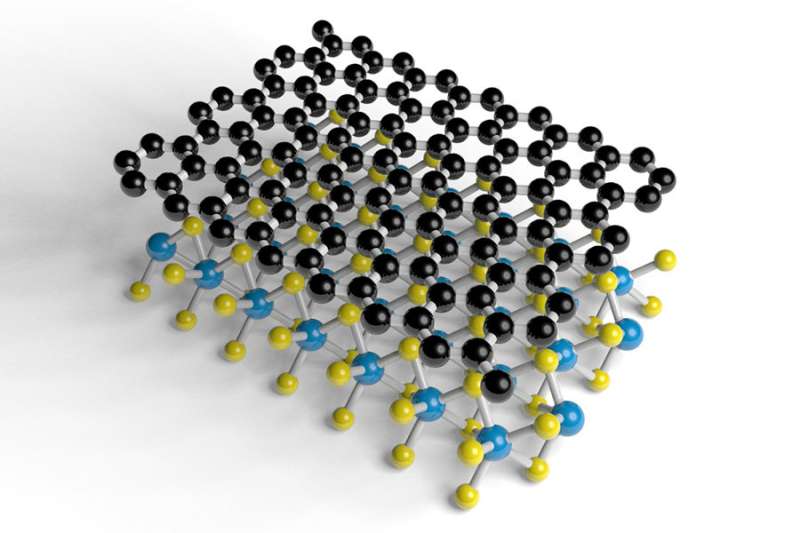Researchers compute unprecedented values for spin lifetime anisotropy in graphene

Researchers of the ICN2 Theoretical and Computational Nanoscience Group, led by ICREA Prof. Stephan Roche, have published another paper on spin, this time reporting numerical simulations for spin relaxation in graphene/TMDC heterostructures. Published in Physical Review Letters, their calculations indicate a spin lifetime anisotropy that is orders of magnitude larger than anything observed in graphene until now. Here, lead author Aron Cummings explains the origin of this effect.
Published in Physical Review Letters this week, spintronics researchers of the ICN2 Theoretical and Computational Nanoscience Group led by ICREA Prof. Stephan Roche have gleaned potentially game-changing insight into the mechanisms governing spin dynamics and relaxation in graphene/TMDC heterostructures. Not only do their models give a spin lifetime anisotropy that is orders of magnitude larger than the 1:1 ratio typically observed in 2-D systems, but they point to a qualitatively new regime of spin relaxation.
Spin relaxation is the process whereby the spins in a spin current lose their orientation, reverting to a natural disordered state. This causes spin signal to be lost, since spins are only useful for transporting information when they are oriented in a certain direction. This study reveals that the rate at which spins relax in graphene/TMDC systems depends strongly on whether they are pointing in or out of the graphene plane, with out-of-plane spins lasting tens or hundreds of times longer than in-plane spins. Such a high ratio has not previously been observed in graphene or any other 2-D material.
In the paper, aptly titled "Giant Spin Lifetime Anisotropy in Graphene Induced by Proximity Effects", lead author Aron Cummings reports that this behaviour is mediated by the spin-valley locking induced in graphene by the TMDC, which ties the lifetime of in-plane spin to the intervalley scattering time. This causes in-plane spin to relax much faster than out-of-plane spin. Furthermore, the numerical simulations suggest that this mechanism should come into play in any substrate with strong spin-valley locking, including the TMDCs themselves.
Effectively inducing a spin filter effect –the ability to sort or tweak spin orientations–, these findings give reason to believe that it might one day be possible to manipulate, and not just transport, spin in graphene.
Spintronics is a branch of electronics that uses the spin of subatomic particles like electrons to store and transport information. It promises devices that are faster, operate at a fraction of the energy cost and have vastly superior memories. However, establishing a spin current is not a straightforward process. First, because spin in its natural state is disordered; that is, the spin axes are pointing in any number of directions. They must first be polarised to tune their orientation. Then, even once polarised, the spins can lose this orientation easily in a process known as spin relaxation, which limits the lifetime and therefore usefulness of spin currents in practice.
Enter graphene, very much the material of the moment and not without good reason: this 2-D material boasts a series of properties that make it uniquely suited for maintaining spin orientation over long lifetimes. However, its low spin-orbit coupling (SOC) makes it ineffective for manipulating spin.
The solution adopted in spintronics is to create layered heterostructures, harnessing the spin transport properties of graphene and a second high SOC material in a single system. This works through the proximity effect, whereby graphene becomes imprinted with the properties of the second material, and has been proven experimentally with 2-D magnetic insulators and transition metal dichalcogenides (TMDCs).
In this work, researchers have studied spin relaxation in such layered graphene/TMDC heterostructures in a bid to shed some light on the as yet unexplored mechanisms governing spin relaxation in these systems. Spin lifetime anisotropy is the ratio of out-of-plane to in-plane spin lifetimes, and is used as a measurement of these mechanisms. What they find is a unique mechanism enabled by the specific proximity effect of TMDCs on graphene.
More information: Aron W. Cummings et al. Giant Spin Lifetime Anisotropy in Graphene Induced by Proximity Effects, Physical Review Letters (2017). DOI: 10.1103/PhysRevLett.119.206601
Journal information: Physical Review Letters
Provided by ICN2





















